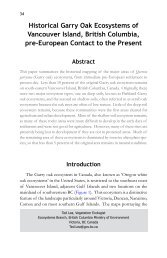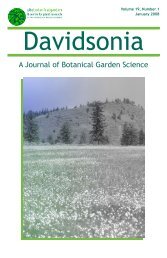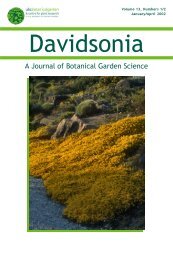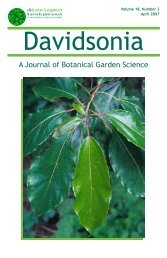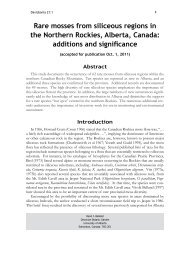pdf wkg Dav.14-14 - Davidsonia
pdf wkg Dav.14-14 - Davidsonia
pdf wkg Dav.14-14 - Davidsonia
You also want an ePaper? Increase the reach of your titles
YUMPU automatically turns print PDFs into web optimized ePapers that Google loves.
<strong>Davidsonia</strong> <strong>14</strong>:4<br />
121<br />
A floristic and ecological analysis at the Tulameen<br />
ultramafic (serpentine) complex, southern British<br />
Columbia, Canada<br />
Abstract<br />
While distinct floristic and ecological patterns have been reported for ultramafic<br />
(serpentine) sites in California and Oregon, those of British Columbia are muted which is<br />
thought to be related to the moderating influence of increased precipitation, a short time<br />
since glaciation, and the presence of non-ultramafic glacial till over ultramafic sites.<br />
Despite these factors, we found clear floristic and ecological differences with respect to<br />
soil type at our study site on Grasshopper Mountain, part of the Tulameen ultramafic<br />
complex in southern British Columbia. Ultramafic soils support 28% of the local species<br />
richness and host more rare taxa than non-ultramafic soils. Many species show patterns<br />
of local restriction to or exclusion from ultramafic soil habitats. Patterns of plant family<br />
diversity also show differences between substrates.<br />
Introduction<br />
Ultramafic (serpentine) soils and the plants that they support have long<br />
been of interest to botanists (Whittaker 1954; Proctor and Woodell 1975;<br />
Brooks 1987). They frequently support vegetation that is distinct from<br />
surrounding areas in species composition and structure as well as high levels<br />
of plant endemism and diversity. For these reasons, and because of<br />
phenomena related to speciation and plant physiological response, Brooks<br />
(1987) and Proctor (1999) asserted that the biological importance of<br />
ultramafics far outweighs the less than one percent of the earth’s surface<br />
they occupy.<br />
The chemical and physical properties of ultramafic soils often have adverse<br />
effects on plant growth (termed the “serpentine effect”). These soils generally<br />
contain elevated concentrations of the heavy metals nickel, chromium, and<br />
cobalt, and high levels of magnesium, all potentially toxic to plants. They<br />
are generally deficient in nitrogen, phosphorus, potassium, and calcium,<br />
thereby further restricting plant growth. The reduced vegetation cover<br />
combined with rugged terrain frequently associated with ultramafic sites<br />
Gary J. Lewis and Gary E. Bradfield.<br />
Department of Botany, University of British Columbia,<br />
3529-6270 University Blvd., Vancouver, BC, Canada, V6T 1Z4.<br />
Corresponding author: garylewis@shaw.ca



